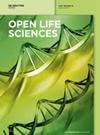Long-term administration of morphine specifically alters the level of protein expression in different brain regions and affects the redox state
IF 1.7
4区 生物学
Q3 BIOLOGY
引用次数: 0
Abstract
We investigated the changes in redox state and protein expression in selected parts of the rat brain induced by a 4 week administration of morphine (10 mg/kg/day). We found a significant reduction in lipid peroxidation that mostly persisted for 1 week after morphine withdrawal. Morphine treatment led to a significant increase in complex II in the cerebral cortex (Crt), which was accompanied by increased protein carbonylation, in contrast to the other brain regions studied. Glutathione levels were altered differently in the different brain regions after morphine treatment. Using label-free quantitative proteomic analysis, we found some specific changes in protein expression profiles in the Crt, hippocampus, striatum, and cerebellum on the day after morphine withdrawal and 1 week later. A common feature was the upregulation of anti-apoptotic proteins and dysregulation of the extracellular matrix. Our results indicate that the tested protocol of morphine administration has no significant toxic effect on the rat brain. On the contrary, it led to a decrease in lipid peroxidation and activation of anti-apoptotic proteins. Furthermore, our data suggest that long-term treatment with morphine acts specifically on different brain regions and that a 1 week drug withdrawal is not sufficient to normalize cellular redox state and protein levels.长期服用吗啡会特异性地改变不同脑区的蛋白质表达水平并影响氧化还原状态
我们研究了吗啡(10 毫克/千克/天)给药 4 周后大鼠大脑特定部位氧化还原状态和蛋白质表达的变化。我们发现脂质过氧化明显减少,这种情况在停用吗啡后的一周内基本持续。吗啡治疗导致大脑皮层(Crt)中的复合体 II 显著增加,同时伴随着蛋白质羰基化的增加,这与研究的其他脑区形成了鲜明对比。吗啡治疗后,不同脑区的谷胱甘肽水平发生了不同的变化。通过无标记定量蛋白质组分析,我们发现吗啡戒断后第二天和一周后,Crt、海马、纹状体和小脑的蛋白质表达谱发生了一些特定的变化。一个共同的特征是抗凋亡蛋白的上调和细胞外基质的失调。我们的研究结果表明,测试的吗啡给药方案对大鼠大脑没有明显的毒性作用。相反,它导致了脂质过氧化的减少和抗凋亡蛋白的激活。此外,我们的数据还表明,长期服用吗啡会对不同脑区产生特异性作用,而停药一周不足以使细胞氧化还原状态和蛋白质水平恢复正常。
本文章由计算机程序翻译,如有差异,请以英文原文为准。
求助全文
约1分钟内获得全文
求助全文
来源期刊

Open Life Sciences
BIOLOGY-
CiteScore
2.50
自引率
4.50%
发文量
131
审稿时长
43 weeks
期刊介绍:
Open Life Sciences (previously Central European Journal of Biology) is a fast growing peer-reviewed journal, devoted to scholarly research in all areas of life sciences, such as molecular biology, plant science, biotechnology, cell biology, biochemistry, biophysics, microbiology and virology, ecology, differentiation and development, genetics and many others. Open Life Sciences assures top quality of published data through critical peer review and editorial involvement throughout the whole publication process. Thanks to the Open Access model of publishing, it also offers unrestricted access to published articles for all users.
 求助内容:
求助内容: 应助结果提醒方式:
应助结果提醒方式:


